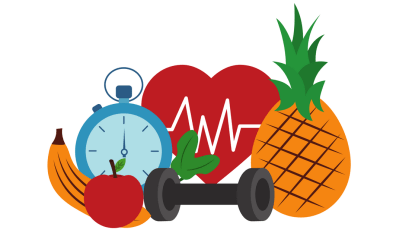Maintaining your body’s health requires that you monitor what you eat, how active you are, and your weight. Positive habits that promote physical health can reduce stress, lower the risk of disease and increase energy. Each card has a checklist on how you can improve your health.
Six Strategies to Improve Your Physical Health
Get Active
Many medical conditions have been linked to sedentary behavior. Sitting less and moving more can be beneficial to your health. Experts recommend that adults engage in at least 150 minutes of moderate activity per week (or two and a half hour). Even a small amount of activity can be beneficial. When it comes to moving, every minute counts.
Increase your activity level:
- Your physical activity should have specific goals.
- Use the stairs rather than the elevator.
- Parking your car in the far corner of the parking lot or street is a good idea.
- Set up your workspace so that you can stand while using a computer or walk on a treadmill when watching TV.
- Stay active at home by taking an online exercise course.
- Set an hourly alarm to remind you to get up and move for a few minutes.
- Use small weights to do arm exercises in the office or at home.
- You can also go for a stroll during your lunch break. You can also have “walking meeting” with your colleagues.
Keep your Muscles Toned
You can continue to do the things you love at any age by building muscle. Strength training can also be beneficial for your bones. Strength training is recommended for adults two to three days per week, and for children and teenagers at least twice a day.
How to build muscle safely
- Begin slowly, particularly if you’ve not been active in a while.
- Listen to your body. Tiredness, sore muscles, and stiff joints are signs that you have overdone it.
- Start with small weights. Add weight gradually, while focusing on your form.
- Lift weights with smooth, steady movements. Do not jerk weights or push them.
- Do not “lock” your leg and arm joints in an upright position.
- Do not hold your breath when doing strength exercises.
- Seek help. Find a class in a gym, recreation centre, or senior center near you. Find a trainer.
Weight Loss Is Important For A Healthy Lifestyle
Maintaining a healthy body weight can help reduce your risk of developing heart disease, diabetes type 2, and certain cancers that are caused by obesity or excess weight. Take control of your weight, and your health.
You can achieve your weight loss goal by:
- Calculate the calories needed to reach your weight goal.
- Use an app or journal to record your daily food intake and physical activity.
- Weigh yourself everyday, or at least one time a week.
- Make sure you have a clear goal. Be realistic in your estimation of time and ability.
- Pick healthy foods and physical activities that you enjoy. It’s more likely you will stick to them.
- Organise physical activities for friends and family.
- Plan ways to stay on track. Plan how to stay on course.
- Learn to learn from your slips. Determine what caused the slip, and then restart your diet and physical activity program.
- It takes time to change lifestyle habits.
Keep Your Metabolism In Check
As you age, your metabolism changes. You consume fewer calories, and your body breaks down food differently. Also, you lose muscle mass. If you don’t exercise and change your diet, weight gain can occur. Middle-age spreading can quickly turn into middle-age sprawl. Carrying extra weight can be harmful to your health.
Age-related changes and how to combat them
- Adopt a healthy eating plan. Choose foods that are high in nutrients, such as fruits, vegetables and whole grains.
- Drink lots of fluids.
- Get moving more Every second counts Add walking breaks and take the stairs to your daily routine. Experts recommend 150 minutes of moderate exercise per week.
- Sleep well.
- Limit alcohol use.
- Do not smoke.
- Regularly visit the doctor.
Eat a Healthy Diet
Every day, we make dozens decisions. It’s easier than you think to make good choices when it comes to choosing what to feed your family. Healthy eating plans include a wide variety of foods that are both healthy and limit unhealthy foods. Learn which foods you should add to your daily diet and which ones to avoid.
Eat a healthier diet
- Choose a variety of food – vegetables, fruits, grains, legumes, nuts, seeds and lean meats.
- Limit the intake of foods low in vitamins and mineral.
- Choose foods with minimal or no sugar added. Choose packaged foods that have less sugar by using the Nutrition Facts labels.
- Use vegetable oils like olive, canola or other types of oil instead butter, meat fats or shortening.
- Increase your fiber intake You can increase your fiber intake over time.
- Your body can adapt to it.
- Choose complex carbohydrates. Consume more complex carbohydrates, such as starches and fibre. They are in cereals, whole grain breads, starchy vegetables and legumes.
- Avoid foods that are high in sodium. Choose fresh poultry, fish and lean meat over canned, smoked or processed. Fresh or frozen vegetables with no salt added and foods that contain less than 5% Daily Value sodium per serving are the best choices. Rinse canned food.
Healthy Habits to Build
Making healthy choices will help us live longer and feel better. You may have already tried to reduce stress, reduce smoking, increase sleep or exercise, or eat healthier. It’s not always easy. Research shows you how to boost your ability for a healthy life style.
